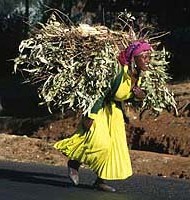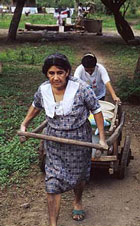|
|
|
|
|
Rural
people have insufficient mobility
|
| Despite
a wide spectrum of transport technologies, in rural areas, much transport
involves either walking and carrying or large-scale motorised technologies.
Rural people need intermediate means of transport that increase capacity
and reduce human drudgery at an affordable cost. |
 Woman carrying wood to market
Woman carrying wood to market
in Ethiopia
|
|
'The missing middle'
In sub-Saharan Africa, much
rural transport involves walking or carrying. In some areas, handcarts
are used for very short distance transport, while bicycles and animal-drawn
carts provide wider circles of transport. Long distance transport
by buses, lorries, pickups and 'bush-taxis' may be available on
the main roads, although such motorised options are generally overcrowded
and expensive relative to local incomes. Moving people and goods
intermediate distances (say 20-50 km) can be particularly difficult
and lack of access to appropriate medium-distance transport can
constrain people from meeting, marketing, trading and producing
efficiently.
|

Women using simple cart to collect
domestic water in Nicaragua
|
|
Why do rural areas have fewer transport innovations?
The development of local
transport solutions is generally faster in urban areas, assisted
by trade patterns, information flows, cultural diversity and year-round
economic activity. A 'critical mass' of mutually-reliant transport
users and support services develops quickly in towns so that innovation,
assessment and adoption can be rapid. The use and diversity of local
transport solutions is less in rural areas. This is particularly
true in sub-Saharan Africa. Processes of innovation and adoption
take longer, affected by lower economic activity, lower availability
of certain materials, fewer cultural exchanges, smaller information
flows and higher seasonality of cash flows and transport demand.
|
|

